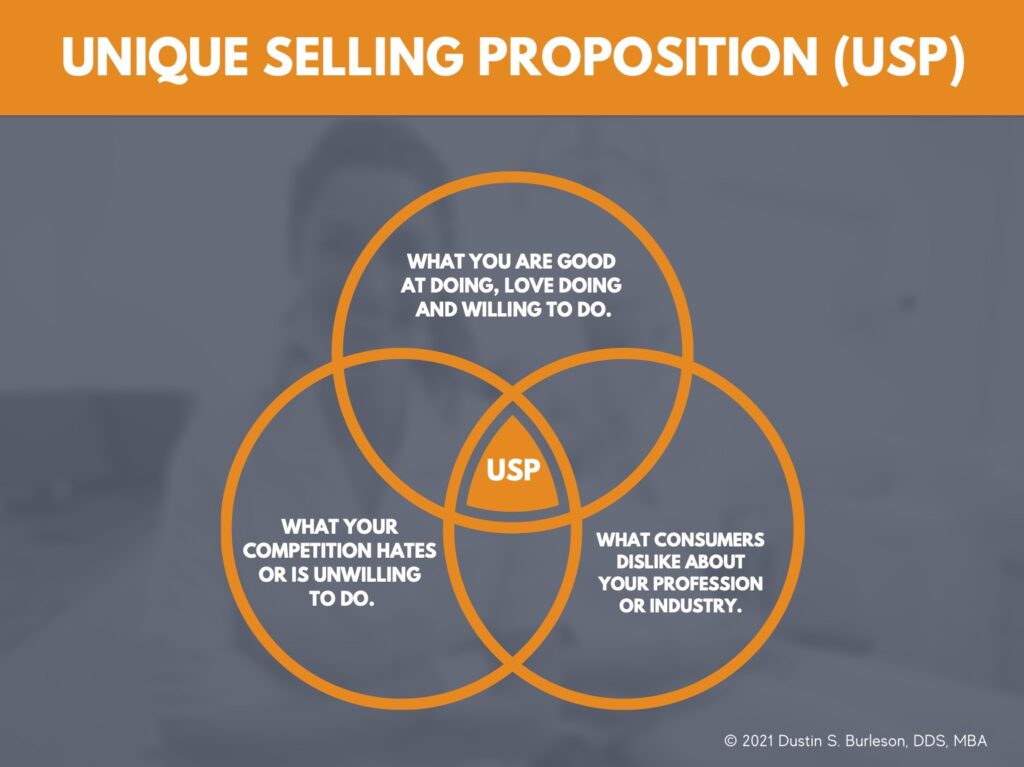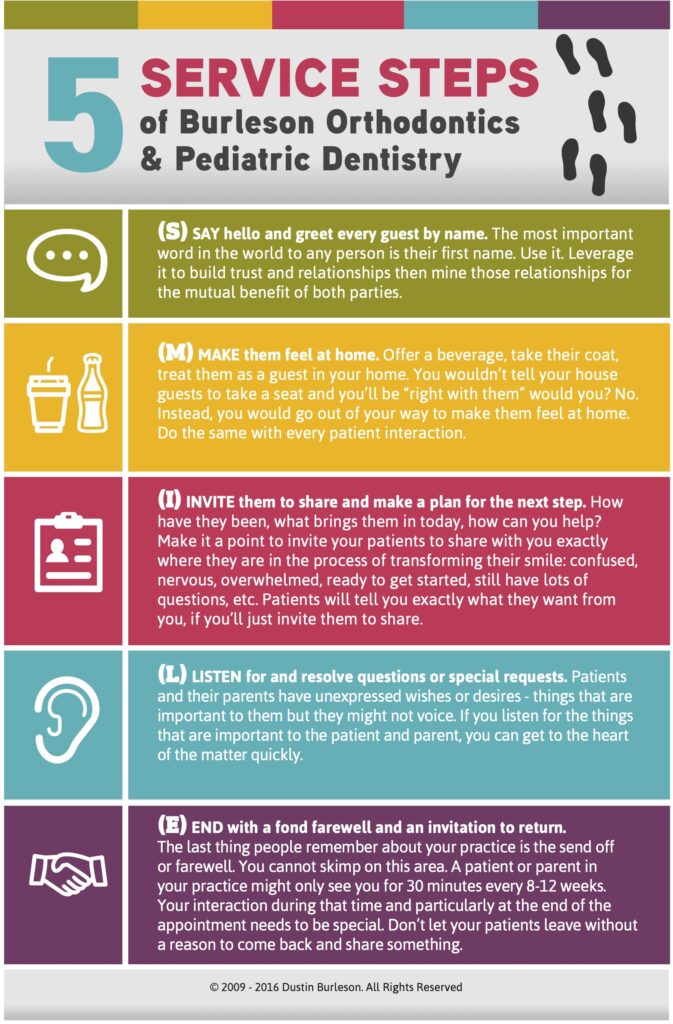I’m often asked “What’s the one thing I can do to attract more new patients to my practice?” and my answer is always the same: there is no one thing. I don’t know one way to attract 300 new patients per month to your practice. I know 300 ways to attract one patient and I recommend embracing all of them. If this sounds overwhelming, no one said private practice was going to be easy. This is business, not a cake walk.
Dentists and orthodontists can attract 25-50 new patients per month without trying. Based on patient churn due to relocation, death and noncompliance, this is somewhere in the neighborhood of the minimum deal flow required to sustain growth.
How can you attract 650 new patients per month, like one of my largest owner-operator members at Burleson Seminars?
First, you don’t need to have this level of ambition. That’s not the point. The big idea is that this member in the top 1% of practices because he embraces all ten of the strategies suggested here. Not one or two from time to time, but all ten simultaneously.
Step-by-step is a recipe for mediocre growth… and mediocre growth is hardly different from not dying.
— Dustin S. Burleson, DDS, MBA
So, while you might not want to grow to 650 new patients per month, the same strategies and principles can help you grow from 50 new patients per month to 100 or more, a worthwhile goal and comfortable amount of deal flow so that the senior doctor can slow down a bit and hire an associate.
1: Referral Programs
In my book, The Truth About Referrals, I list five reasons why patients don’t refer. We all know word-of-mouth recommendations are one of the most powerful ways to attract new patients, but how can you consistently generate internal referrals at a high level?
One reason why patients don’t refer is that they don’t know how / they aren’t given adequate tools. You wouldn’t be shocked if I told you a new patient has never run home to their spouse and said, “Honey! Come quick. You have to see what Dr. Smith is doing with his new diode laser.” So, how can you give new patients a tool they can take home to their friends and family? Do you have a consumer book or report about TMD or cosmetic dentistry which answers common questions and provides sample photos for prospective new patients to learn more about you? Are you in the habit of sponsoring or hosting local events, community festivals and patient appreciation events where patients can bring friends, family and coworkers to an environment where you’re not behind a dental chair, wearing a mask and gloves?
Give them a reason to talk about you (e.g., my dentist gave me two tickets to the Food and Wine Festival, I think they are going to have a whitening tent there, would you like to go?) and give them a tool for referrals (e.g., online registration, physical tickets, book, report, etc.)
Unless you’ve been living under a rock, you already know Taylor Swift’s tour is a hot ticket item and most likely a popular event with your target audience. Could you give away a random raffle prize and hand out referral cards so that patients have something to talk about other than your dental laser? Food for thought.


2: Website and Digital Marketing
Establish a strong online presence through a professional website and social media platforms. Make sure the copywriting on the website was written by experts in direct-response marketing. Ask them how they will user test the website and measure success. How many unique visitors per month visit your site? How long do they stay on the site, what ads brought them to the site, where do they spend the most time, what pages do they visit, and what is the conversion rate from lead to scheduled new patient? Optimize your website for search engines to improve visibility. Use targeted online advertisements, including Google AdWords and social media advertising, to reach potential patients in your local area. My good friends at Socius can help you. Tell them Dustin sent you.
I’m often baffled by the answer I get when I ask doctors how much they are spending on paid search, display ads, social media and retargeting. They often don’t know and 75% or more are not making adequate investments in these media channels. The average professional practice owner is spending too much on human capital and too little on marketing and advertising. You might not like when I say it, but that doesn’t make it untrue: you are really in the marketing business. Whether you straighten teeth, place implants, reconstruct jaws or negotiate contracts for a living, if you own a professional practice in a free market, you are in the marketing business. How well you are doing is in direct relationship to how much you acknowledge and embrace this truth and then do something smart about it.
3: Content Marketing
Create and share informative and engaging educational content related to your specialty. This can include blog articles, videos, infographics, and social media posts. Provide valuable information about treatment, general health tips, and success stories to establish yourself as the go-to expert and build trust with potential patients.
Search engine companies want their users to have a great experience. If you were to search for “running shoes” and land on a page all about organic gardening, unless you’re extremely bored, you’d probably click the back button in a millisecond. Search engines will penalize you for this and the metric they used is called the “bounce rate.” This represents how many people leave your site after viewing only one page. You want to do the opposite. Be sticky. Give readers plenty of options when they land on your site so that they spend more time and click more pages. Search engines like this. It means they served up the right page for their user to engage with answers to their questions, solutions to their problems or satisfaction to their curiosity.
4: Local SEO (Search Engine Optimization)
Implement local SEO strategies to ensure your practice appears in search engine results when people search for orthodontic services in your area. Optimize your website with relevant keywords, register your practice on local business directories, and welcome positive online reviews from satisfied patients.
This is an area where you should hire an expert. Listen. You’re very smart and capable. I get it. You went to professional school and then residency and I’m confident you could do you own SEO but why? What is your most valuable contribution to the business, your patients, community and mission? It should be either leading the company as the visionary, treating patients or both. I doubt it’s “develop and deploy our SEO strategy.”
But I see so many dentists and orthodontists try to do their own SEO under the guise of saving money that it almost always results in three things: inconsistent results, poor performance, and slow adoption. SEO is a non-stop function of digital marketing. You’re never done with SEO. It isn’t something you do once and then put on a shelf. Your budget might not need to be as high after you’ve achieved some “lift off” and ranking results, but you’re never quite done and so it has been my experience that the doctors who are actually pretty good at SEO are not good at it for long enough. They get distracted and quit and that’s kind of like telling Google you’re closed for business. Hire the pros. Again, we love and recommend Socius.
5: Community Engagement
Participate in local events, sponsor school programs, and collaborate with other healthcare professionals to raise awareness about your practice. Building relationships within the community can generate referrals and enhance your reputation. These are often very inexpensive ways to get in front of a lot of eyeballs.
If you’ve never done community events before, start small. Pick three to four events you can do in the next 12 months. Identify team members who can be at these events. Make sure they have a table, nice tent or booth (again doesn’t have to be expensive), a laptop and wireless hotspot for scheduling new patients and a reason for people to come by your booth.
We started doing bridal fairs before Invisalign started telling their members to do bridal fairs. I saw so much money being spent in one place on things like flowers, cake and music that come and go that I thought, “Why wouldn’t we be there to give brides something they can keep forever? (i.e., straight teeth in their wedding day photos)” It worked.

Our best day ever at a live event, we started 26 new patients in Invisalign treatment. Some were express treatment, but the majority were comprehensive cases. That was a very productive Saturday for our practice and a life changing opportunity for 26 brides.
6: Online Appointment Booking and Patient Convenience
Offer an easy and convenient online appointment booking system. If you’re an orthodontist, we recommend Greyfinch as a PMS. Their appointment widget allows leads to schedule directly into the patient database and can start the next steps without ever leaving the practice website browser window. Give your patients flexible scheduling options, including evening and weekend appointments, to accommodate patients’ busy lifestyles. If your last new patient exam slot is 4PM and I can schedule busy moms and dads at 5PM, 6PM and 7PM, I’m going to win the convenience battle in the marketplace. The more accessible and user-friendly your practice is, the more likely patients will choose your services. I wish patients chose me because I was an amazing doctor when I was in private practice, but we started hundreds of new patients per month because we made it easier for them to say “Yes!” to our office versus our competitors.
If you need the hard data, reach out to my friends at OrthoFi and Greyfinch. Ask them how many new patients are scheduling after hours online with the practices who offer this feature. Then, sit down because the back of your head is going to blow straight off when you see the numbers. It’s unreal.
7: Patient Testimonials and Reviews
One of the five reasons why patients don’t refer is that the experience is good enough but not exceptional. From Pew to Boston Consulting Group, Bain and Harvard Business Review, the stats vary a little but they are all overwhelmingly supportive of the fact that something like 80% of companies think they provide superior service to their customers but only 8% of customers agree. The state of customer service is sad but this presents a tremendous opportunity for you and your business.
So, instead of telling you to encourage satisfied patients to leave positive reviews and testimonials on your website, social media platforms, and online review sites, I going to suggest some very simple advice. Establish service steps and stick to them. If your team is underperforming in customer service, raise your expectations.
8: Educational Seminars and Workshops
Organize educational seminars or workshops to educate the community about the importance of orthodontic treatments and oral health. This helps build credibility, establishes you as an authority, and provides an opportunity to connect with potential patients and referring dentists.
The more of these talks you give, and especially if you have published consumer books and reports, you’ll be much more likely to get invited on the local news via radio or television. Don’t forget that many events have already been organized and groups are always looking for speakers.
I’ve been asked to speak about cleft lip and palate to dental hygienists, to pre-dental and dental students on behalf of local and state dental societies, to residents and business leaders by schools and software companies, etc. None of these invitations came at a time where I thought I was the world’s ultimate authority on a topic, but nonetheless they came and I had to decide how I would add value and serve others. Often it’s more than enough to simply say yes and figure it out later. You’re the only person on the planet that has taken your exact path to get where you are today. That makes you an expert in your experience and people love to learn about others and their life stories. Start sharing yours today and you’ll be shocked how many people want to engage with you, your business and brand.
If you organize your own seminars and workshops, be sure to ask around and see if any dental suppliers or third-party vendors might be willing to pick up the cost of the dinner or event space. These companies will provide speakers if you’re not comfortable giving the presentation, but I’m not a huge fan of a corporate entity bringing a polished speaker to the stage to speak about how great their products and services are. I’d rather host a topic of interest to my audience (patients, dentists, hygienists, or physicians) and then invite some guest experts to fill in any areas of expertise I might be missing.
For example, one of our most popular events each year was a seminar where we discussed tax strategy and estate planning. We invited our attorney and CPA to speak and it was always our best-attended and most productive meeting because we presented concepts, explored ideas around those concepts and then allowed the group to ask a ton of questions. If you teach your referral network how to save money, they will love you forever.



Be sure to get photos and post to your social platforms, patient newsletters, etc. We had a saying in my office, “If we didn’t take photos of it, the event never happened.” Photographers are well worth the investment and not that expensive. You’d be surprised how many times before we adopted this strategy that we would finish and event and say, “Did anyone take some photos?” Without fail, we’d have zero or only a few photos, out of focus in bad lighting and not worthy of being published online or in our newsletter.
So, get a photographer and use those photos to invite attendees to your next event. We think you should be doing at least two of these events per year, so that your referring colleagues can see you in person at least every six months.
9: Support Referring Colleagues
Establish strong relationships with local dentists by offering your expertise and providing exceptional patient care and education or advice when solicited. Dentists can refer a lot of patients to orthodontic practices, and a positive working relationship is not only good for your practice but good for the patient first and foremost. I was never shy about teaching dentists how to get better results from their Invisalign ClinChecks. Other orthodontists in my market thought this was a dumb thing to do, but I knew the general dentists who were looking for malocclusion and then learned which cases they could and could not treat, were much more likely to refer patients for orthodontic treatment.
It’s kind of alarming how many general dental patients get referred to an orthodontist only if the teeth are crowded. I worked as a general dentist in a large group practice before becoming an orthodontists and in my first month, I diagnosed 14 posterior crossbites. The exam included the words “open wide” but not the words “bite down.” If the lower front teeth were crowded, a referral was made to the orthodontist by handing one of three business cards (or all three) to the parent. If the lower front teeth were not crowded, even if the patient had 12 mm overjet and a posterior cross bite, the patients weren’t being referred.
Ichanged all that, at least with my patients and on the days I covered hygiene, and an orthodontist friend in the area asked me, “Do you have a brother or uncle near my practice?”
I said, “No. Why do you ask?”
He said, “There’s some guy named Burleson referring a ton of patients to me.”
“That’s me,” I said. “You’re welcome.”
Nurture your professional relationships. Never ever take them for granted. Professional referrers want a lot more from your office than a basket of muffins. Find their hot buttons (i.e., what makes them tick) and push those buttons over and over again (i.e., give them what they want in a way that adds value to their practice and their goals). Then sit back and watch your new patient numbers soar.
10: Exceptional Patient Experience
I mentioned earlier the fact that most companies think they provide exceptional service but a small minority of customer agree. How should you focus on delivering outstanding patient care at every touchpoint? Start by understanding your customer better than the competition and then stay closer to them and build a stronger relationship with them. You must provide much more than a welcoming environment, friendly team, and personalized attention.
Ask what would make your customers drive past five competitors and across state lines to get to your business. Make a list of all the things in your industry or profession that annoy customers. Then make a list of all the things your competitors are unwilling to do or incapable of doing. Sometimes it’s speed. Often it’s convenience or risk removal. It’s always a whole lot more than “we’re nice people and we treat our customers well.” Everyone in business should be nice and treat their customers well. If they aren’t, my strong advice is to get out of business.
So, what are you really doing that is unique? What would make someone happy to talk about you with a friend or neighbor? Do you offer your customers bragging rights?

“Our orthodontist is open on Thursday evenings and Saturdays. It’s so nice. We don’t have to take the kids out of school for appointments. We love it there.”
You already know that a positive patient experience can lead to patient loyalty and positive word-of-mouth referrals, but you have to go deeper. What are you really doing that consumers can’t find anywhere else? Don’t sleep until you have an answer to that question.
— Dustin S. Burleson, DDS, MBA
The New Patient Attraction MasterClass gives you all of the tools you need to increase the best new patients for your practice, convert them into same-day starts, and earn referrals from patients and dental professionals. You’ll learn how to stop the ups and downs of new patient conversion, showcase what makes your practice unique, and gain the confidence to consistently start 90% or more of your new patients. Learn more here.



Leave a Reply